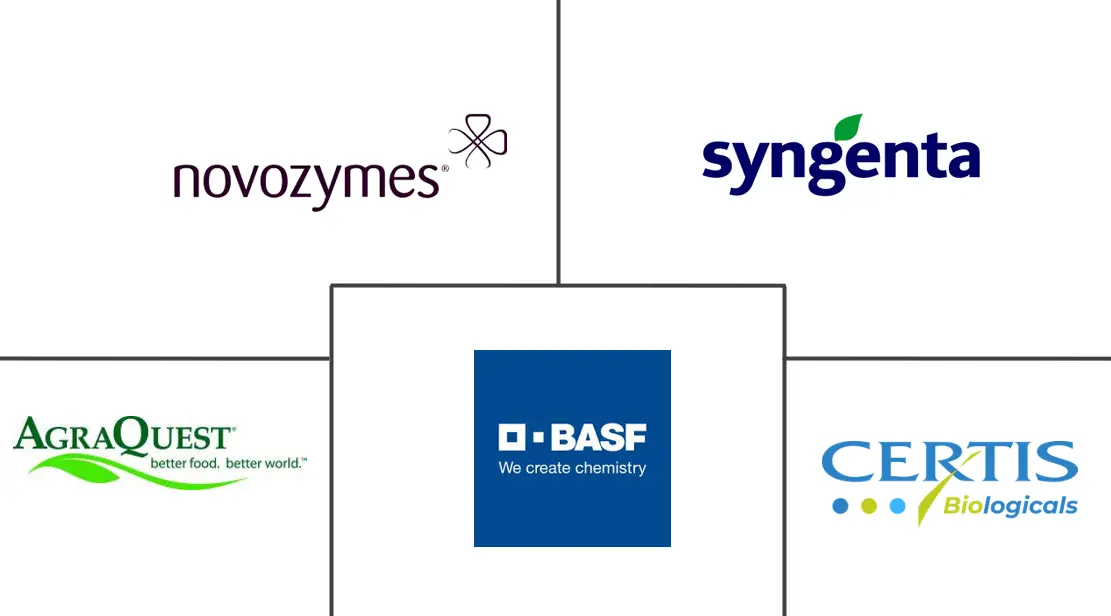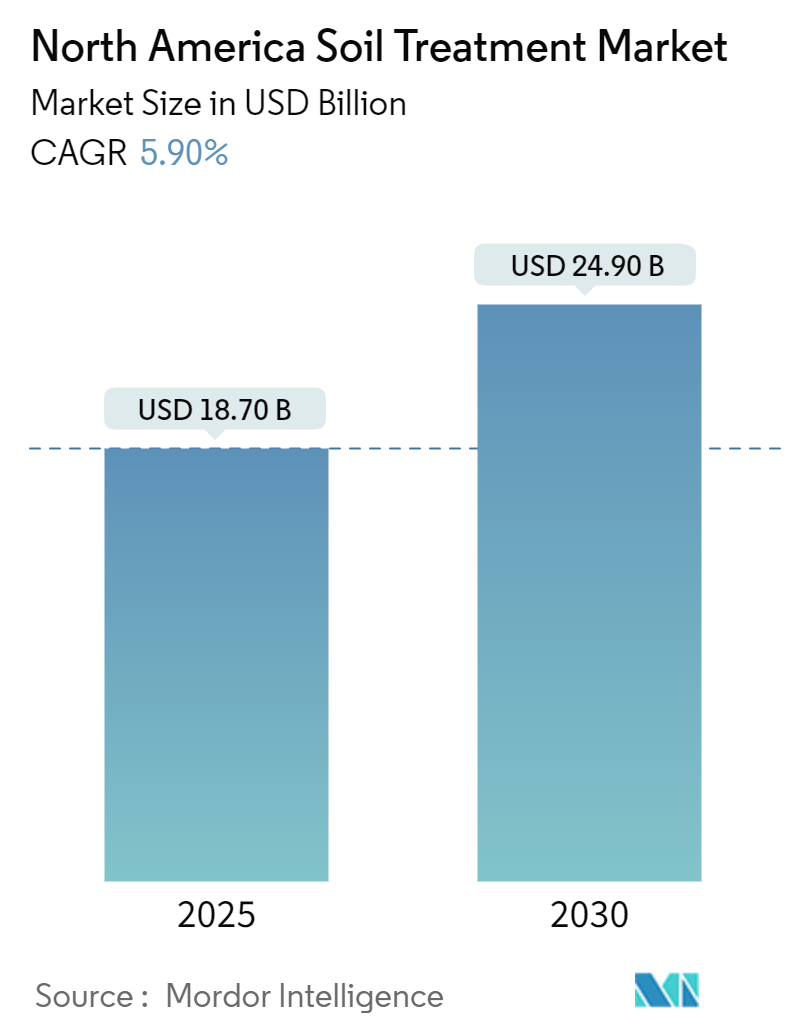
North America Soil Treatment Market Analysis by Mordor Intelligence
The North America Soil Treatment Market size is estimated at USD 18.70 billion in 2025, and is expected to reach USD 24.90 billion by 2030, at a CAGR of 5.90% during the forecast period (2025-2030).
- The soil treatment industry is undergoing significant transformation through the comprehensive integration of modern farming practices and precision agriculture technologies. Agricultural operations are increasingly implementing no-till and minimum-till farming methodologies, necessitating sophisticated soil treatment approaches. These agricultural advancements have facilitated the development of precision application technologies that systematically identify and target areas with high weed concentration, resulting in optimized pesticide utilization and substantial cost reductions. The implementation of advanced GPS-guided systems and sophisticated soil mapping technologies enables highly precise and resource-efficient application of soil treatment products. The escalating concerns regarding soil contamination across North American nations, particularly in the United States, Canada, and Mexico, have intensified the implementation of comprehensive soil treatment programs in agricultural lands.The progressive reduction in arable land availability throughout the region represents a critical factor accelerating the soil treatment industry's expansion.
- The soil treatment market expansion is driven by multiple interconnected factors, including the increasing frequency of soil pollution incidents, widespread adoption of biological products across various applications, substantial growth in the organic agricultural sector, and the systematic implementation of integrated pest management practices. Regional governmental and institutional initiatives provide substantial support for market development. A significant example is the USDA's 2023 investment of USD 32.5 million dedicated to research innovations in soil health enhancement and climate-smart agriculture and forestry practices. The convergence of strategic investments in soil health improvement initiatives, ongoing challenges of regional arable land reduction, and the comprehensive impact of aforementioned market drivers indicates sustained and robust growth trajectories for the North American soil treatment market throughout the forecast period.
North America Soil Treatment Market Trends and Insights
Thermal Treatment Holds Significant Position
Thermal treatment plays a significant role in the North American soil treatment market by effectively addressing soil contamination, improving soil health, and restoring land for agricultural and industrial purposes. The process involves applying heat to contaminated soil to destroy or remove pollutants such as heavy metals, organic compounds, and hazardous chemicals. This method is essential for industries managing polluted lands, including manufacturing and oil and gas sectors, as well as urban development projects.
Thermal treatment methods, including thermal desorption and incineration, efficiently remove contaminants such as volatile organic compounds (VOCs), polycyclic aromatic hydrocarbons (PAHs), and petroleum hydrocarbons. In North America, where industrial activities have caused extensive soil contamination, these methods are particularly important. For example, in Texas's oil and gas industry, thermal treatment methods remediate soils contaminated with petroleum products through thermal desorption systems that heat the soil and remove contaminants for safe disposal or recovery.
According to the World Bank, North America's population increased from 376.9 million in 2018 to 378.9 million in 2022, with significant growth projected over the next 30 years. This population increase has led to projections of doubled food demand, raising concerns about food supply capabilities and agricultural sustainability. Industrialization and urbanization have caused a continuous decline in arable land per person across the region. World Bank data shows that arable land remained at 0.53 hectares per person between 2022 and 2023, despite growing population demands.
In-situ thermal remediation allows for the treatment of contaminated soil without site removal. This approach minimizes land disruption, reduces transportation costs, and decreases the environmental impact of cleanup processes. Urban development projects in cities like New York and Chicago utilize in-situ thermal treatment to manage contaminated soils on-site, eliminating large-scale soil removal requirements, reducing logistics costs, and accelerating remediation processes.
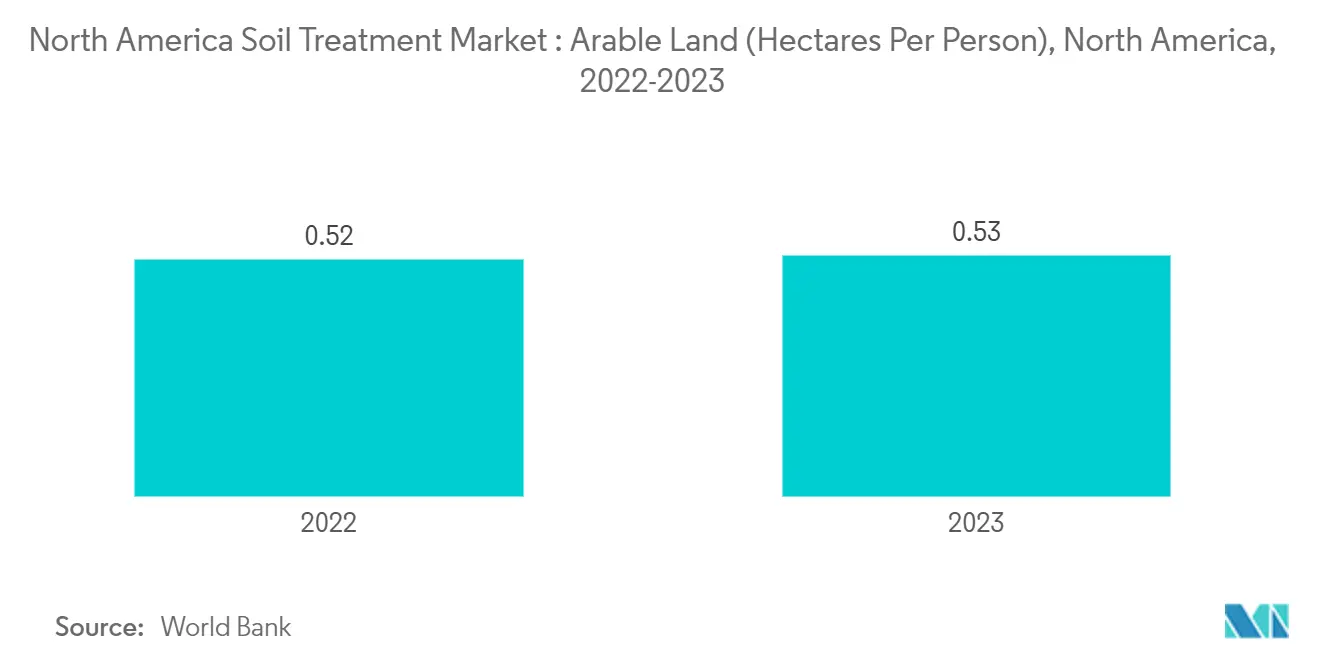
United States Dominate the Market
The United States dominates the North American soil treatment market due to its extensive land area, industrial diversity, strict environmental regulations, and investments in soil remediation technologies. The agricultural sector's concerns about chemical fertilizer usage have prompted a transition to organic alternatives. This shift is evidenced by the expansion of organically farmed land, which reached 2,060,741.00 hectares in 2023. Regional governments have implemented programs to promote organic amendments and soil health awareness, as balanced soil nutrients are essential for optimal crop yields. These organic amendments have enhanced soil structure, microbial activity, and moisture retention capacity.
The growing demand for soil treatment in the United States is driven by increasing crop production. According to FAOSTAT, vegetable production increased from 29.4 million metric tons in 2022 to 31.5 million metric tons in 2023. To support population growth and sustainable agriculture, farmers are adopting soil treatment methods to improve soil health and enhance crop yields. These treatments address deficiencies in essential nutrients like nitrogen, phosphorus, and potassium, which are fundamental for crop growth.
The U.S. Environmental Protection Agency (EPA) maintains strict environmental regulations, including soil and land remediation requirements. The EPA's Comprehensive Environmental Response, Compensation, and Liability Act (CERCLA), known as the Superfund program, has focused on contaminated site remediation. This regulatory framework has increased the demand for soil treatment technologies, including bioremediation, chemical treatment, and thermal treatment methods.
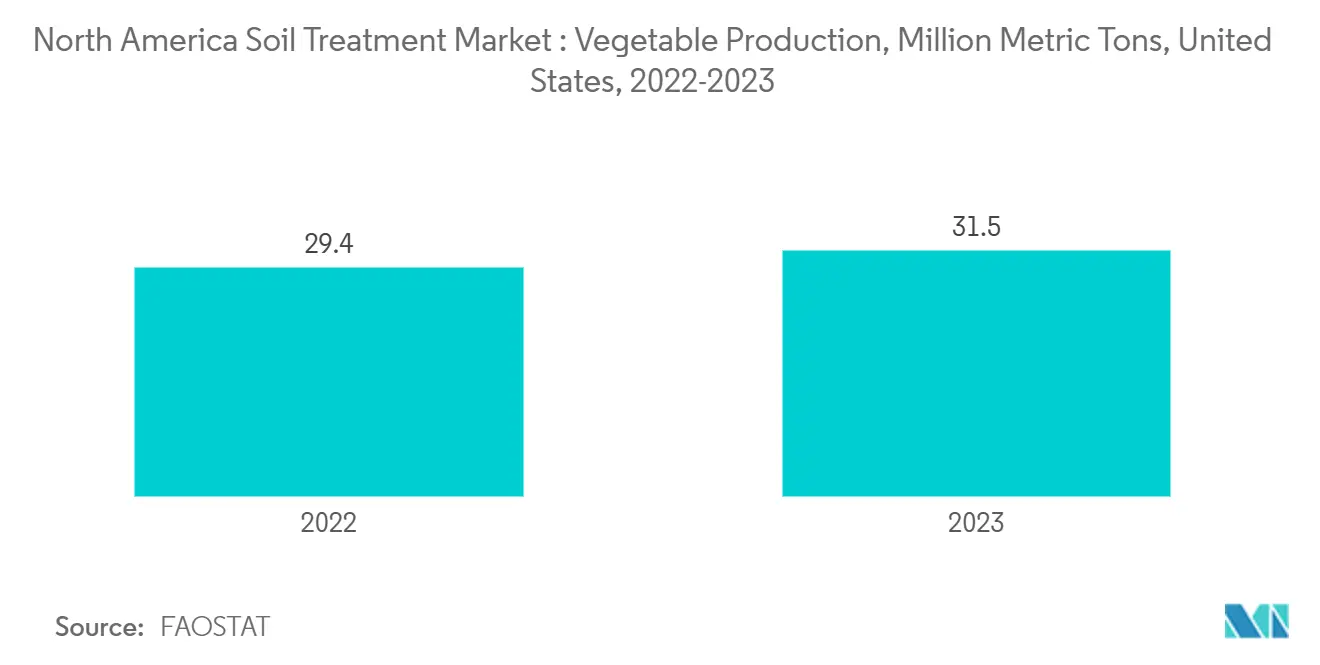
Competitive Landscape
The North America Soil Treatment Market is consolidated, with players such as BASF SE, Agraquest Inc., Novozymes A/S, Syngenta AG, and Certis USA Llc etc. The players are investing in the improvisation of products, partnerships, expansions, and acquisitions for business expansions.
North America Soil Treatment Industry Leaders
-
BASF SE
-
Agraquest Inc.
-
Novozymes A/S
-
Syngenta AG
-
Certis USA Llc
- *Disclaimer: Major Players sorted in no particular order
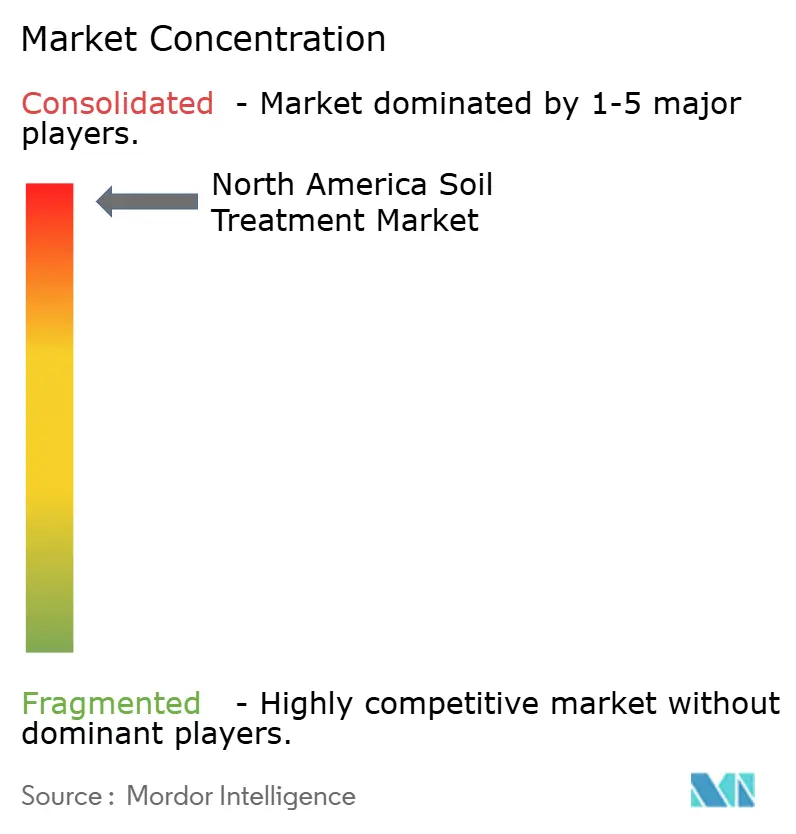
Recent Industry Developments
- June 2023: MustGrow Biologics Corp. signed an agreement with Oregon-based Bio Ag Product Strategies to develop and commercialize MustGrow’s soil amendment and biofertility technologies. This is anticipated to support the growth of the soil treatment industry in the coming years.
- May 2022: UPL, a global leader in sustainable agriculture solutions partnered with Kimitec’s MAAVi Innovation Center to Commercialize BioSolutions. The partnership is aimed to deliver tailored bio solutions technologies in the United States, particularly for soil amendments and treatments.
North America Soil Treatment Market Report Scope
Soil treatment refers to the application of physical, chemical, and biological processes or products to alter, improve, or correct soil conditions. The North America Soil Treatment Market is segmented by Technology (Physiochemical Treatment, Thermal Treatment, and Biological Treatment), Type (Organic Amendments, pH Adjusters, and Soil Protection), and Geography (United States, Canada, Mexico, and Rest of North America). The report offers market size and forecasts in terms of value (USD) for all the above segments.
| Physiochemical Treatment |
| Thermal Treatment |
| Biological Treatment |
| Organic Amendments |
| pH Adjusters |
| Soil Protection |
| North America | United States |
| Canada | |
| Mexico | |
| Rest of North America |
| Technology | Physiochemical Treatment | |
| Thermal Treatment | ||
| Biological Treatment | ||
| Type | Organic Amendments | |
| pH Adjusters | ||
| Soil Protection | ||
| Geography | North America | United States |
| Canada | ||
| Mexico | ||
| Rest of North America | ||
Key Questions Answered in the Report
How big is the North America Soil Treatment Market?
The North America Soil Treatment Market size is expected to reach USD 18.70 billion in 2025 and grow at a CAGR of 5.90% to reach USD 24.90 billion by 2030.
What is the current North America Soil Treatment Market size?
In 2025, the North America Soil Treatment Market size is expected to reach USD 18.70 billion.
Who are the key players in North America Soil Treatment Market?
BASF SE, Agraquest Inc., Novozymes A/S, Syngenta AG and Certis USA Llc are the major companies operating in the North America Soil Treatment Market.
What years does this North America Soil Treatment Market cover, and what was the market size in 2024?
In 2024, the North America Soil Treatment Market size was estimated at USD 17.60 billion. The report covers the North America Soil Treatment Market historical market size for years: 2019, 2020, 2021, 2022, 2023 and 2024. The report also forecasts the North America Soil Treatment Market size for years: 2025, 2026, 2027, 2028, 2029 and 2030.
Page last updated on:
North America Soil Treatment Market Report
Statistics for the 2025 North America Soil Treatment market share, size and revenue growth rate, created by Mordor Intelligence™ Industry Reports. North America Soil Treatment analysis includes a market forecast outlook for 2025 to 2030 and historical overview. Get a sample of this industry analysis as a free report PDF download.
